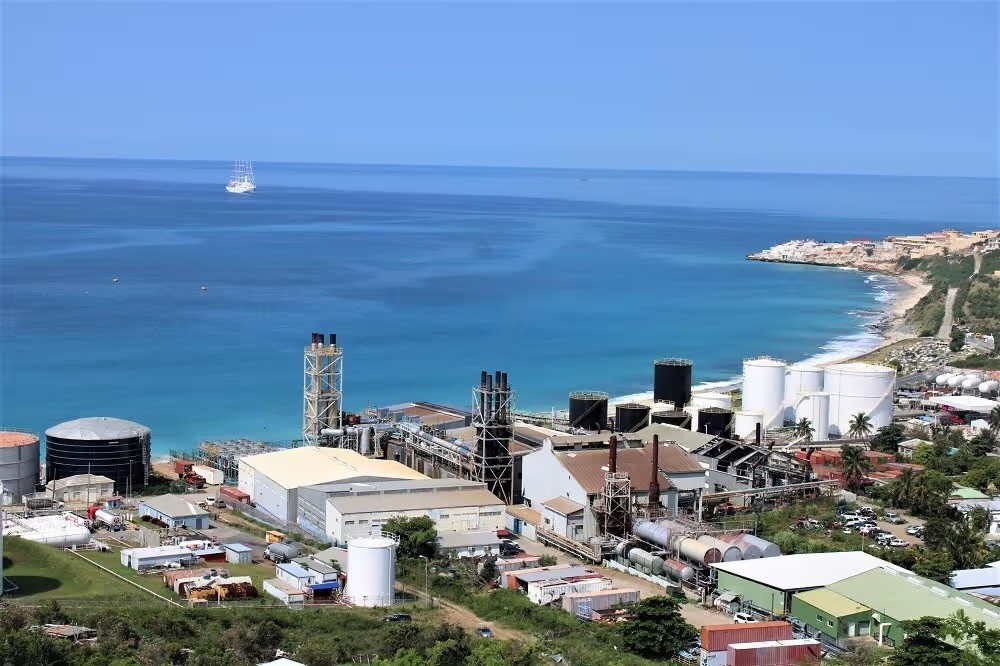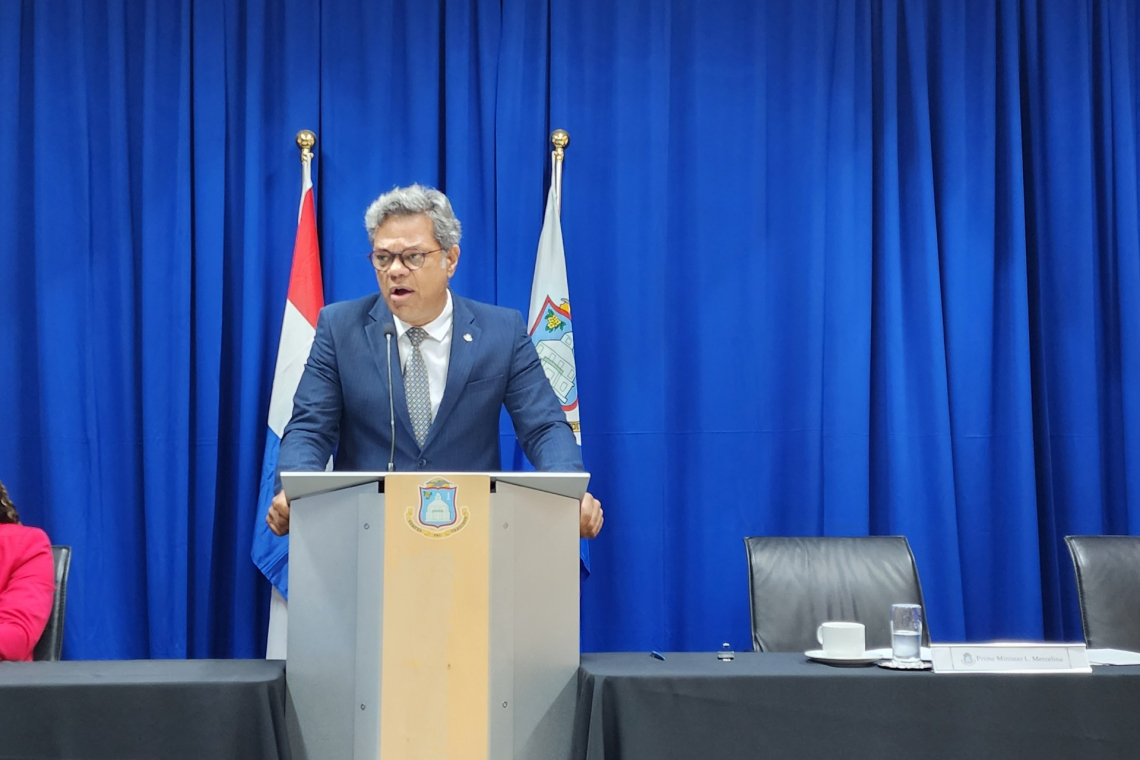Prime Minister Dr. Luc Mercelina speaking to reporters at the bi-weekly press briefing on Wednesday.
~ Talking to consortium, looking into Capex funds ~
PHILIPSBURG--Prime Minister (PM) Dr. Luc Mercelina on Wednesday gave a clearer and more detailed insight into the various options being looked into to help resolve the current energy crisis plaguing the country.
He also provided some preliminary figures as to what the various options are likely to cost and indicated that he has sent letters to both the World Bank and the Dutch government asking for assistance to help St Maarten finance the solutions being pursued.

The GEBE power plant.
Government is also looking into the 2024 Capital Expenditures Capex as a potential avenue of financing and is currently engaged in talks with a consortium that includes investors and commercial banks.
Finance Minister Marinka Gumbs had said at a press conference last week that the Capex funds cannot be diverted to cover expenses other than the capital projects that they are intended to finance, and diverting the funds for other purposes would violate the terms of the funding agreement and could jeopardise future funding opportunities.
Options
Mercelina said government has to look for immediate solutions that can be accomplished in the next six months as well as short-term solutions to start immediately, but go into effect six months from now and continue for the next 24 months, when the long-term solution, the planning of which is to start now, will be put into effect. He said government has been looking around for options and solutions.
The first solution is containerised generators. “There are two options for this generator container search. The first one is the option of just renting the container – rent those containers, they come on the island, you pay a monthly fee. Added to that is fuel price … and after the amount of period that you had a contract with this company, the containers will be recollected and they leave the island,” Mercelina told reporters.
The second option is to lease-to-own containerised generator. “That is a second option that we are looking into and we are quite far already in analysing the options that we have.”
The third option is renting a power boat (power barge). He said there are two barges in the Dominican Republic, one in Guyana and one in Brazil. “So, we are negotiating with those companies that have these boats in the vicinity to see how we can get an agreement with them.”
The fourth option is combining the power barge with the rental of a containerised generator and the fifth option is to combine the rent-to-own containerised generator with the power barge/boat.
Mercelina explained that finances are not just needed for the short term and immediate options (containerised generators and/or the power barge/boat), but also for the long-term
option which is to acquire three generators, which GEBE had said last week would cost between US $30 million and $45 million, to replace the generators that are past their 30-year lifespan. Consideration is also needed for cost for the country’s vision plan for renewable and green energy and for investing in the reorganisation of the infrastructure of the power plant.
“You cannot order three huge, expensive diesel generators and leave the plant as it is and you do not have the infrastructure with security to make sure that you treat these very expensive units well, to ensure that they have a respectable lifespan too,” said Mercelina. “Next to that we are looking also into the possibility to build a fuel farm to also give some sustainability in the nearby future.”
He said the various stages of recovery go parallel with each other. “It’s not the one following up to the other. So, your financial package preparedness plan that you have has to be very strong to deal with all these five to six pillars that I just mentioned. It’s not that you just need money now for generators [and] containers, no, you have money now to start upfront to get this going for over two years from now.”
Expenses
According to Mercelina, preliminary expenses to just rent containers will be approximately $500,000 per month, while for the lease-to-own concept, a settlement of $200,000 per month is to be paid over a 36-month period.
“It’s big, big money we are talking about while outside there are people playing politics. That’s why this government is not entertaining the community malice because this is a serious national matter and we do not have time to play politics with what is going on. This is a serious national problem,” Mercelina said. “All the figures that I mentioned are preliminary figures. Those definite figures are coming tomorrow [today – Ed.] and we are talking here about exclusiveness of fuel consumption. So, we didn’t talk yet about the consumption of fuel to keep these containers going.”
As it relates to megawatts (MW), preliminary figures indicate that the power boat will cost approximately $163 per MW per month, which Mercelina said is “$0.09” per kilowatt-hour (kwh), while the containerised generators fluctuate between “$0.04 and $0.07 to $0.09 per kwh” or “$30,000 to $52,000 per MW per month.”
Additionally, the crank shaft of GEBE generator Unit 19, one of the generators that is past its 30-year lifespan, is broken and will cost $2.5 million to replace. The prime minister said a decision has to be made to whether change the crankshaft or go the “heroic route of moving forward with containers and start ordering the new generators once the financing is in place.”
Timeline
If the containerised generators are chosen, it will take approximately 12 weeks (three months) for them to be operational on-island barring any unforeseen circumstances such as hurricanes. The containerised generators will have to be ordered, shipped to the island and connected and installed at GEBE’s power plant.
“We cannot continue like this. We realise that we are in the hurricane season and we are also realising that the high season is coming. We decided that we must have to have a much earlier solution for this problem and that’s why we are going to combine it with a power boat and the power boat can be the moment we make a deal, settle and do a down-payment; we can have a power boat here on the island in approximately four to six weeks,” he explained.
“To get the boat only here will cost us between $1 million and $3 million just to get the boat on the coast here. We are talking again here about a serious amount of money. No time to play politics again. … Sometimes they can do their best that they can get the boat here weeks after ordering. So, the earliest we can get the power boat as we decide to order is three weeks from
now.
“We will try to install our generator containers [and] we are going to … disconnect from the power boat, give it back to the company and we are going to continue with what we have on the plant that is functional and will move forward only with the generators that will assist us on the power supply.”
The three new diesel generators will each provide approximately 9-10MW of power. GEBE can currently supply 40MW, but requires 57MW during peak periods, a shortfall of 17MW.
Seeking financing
According to Mercelina, government is looking into how it can assist and is “working on seeing what we can do with the Capex of our budget of 2024 in this crisis situation.” He explained that government will “have to have a backup buffer function in all these negotiations as a government. We cannot stand as shareholder representative without showing our goodwill intention and responsibility to have some buffer offering to this negotiation table.”
Government is also working on engaging in talks with a consortium on a national level consisting of banks and other institutional investors “to see if we can get a group of people motivated.”
A letter was also sent to State Secretary of Kingdom Relations and Digitisation Alexandra van Huffelen to apprise her of the situation and to ask for financial help. A letter was also sent to the country director of the World Bank regarding the St. Maarten Trust Fund, which was copied to World Bank stakeholders, also asking for financing.
“We are not in an emergency state. We are in a crisis situation and I think that our partners in the Kingdom should not only be informed, but I added a significant part of my letter to ask their attention to see if they can financially help us to finance the project … to get the country back in stability and balance concerning the energy supply for our country.”
Overview
Mercelina said he has had several meetings with GEBE: official meetings were held on May 30 and on June 7. Today, Thursday, he will have a third meeting with GEBE to get a total overview from the company so that “we are well informed as shareholder representative of GEBE for us to take together a responsible decision for continuity of energy supply for our country. The meeting of tomorrow [today] that starts at 2:00pm is a very important meeting that everybody is now finalising their homework for us to make a decision on how we are going to move forward for the coming two years,” said Mercelina.
“We realise that there are not many other options than what we presented. Our restriction or what is critical for us is that all this has a financial picture and we have to make sure as a country once we take that decision that we can carry on the responsibility for the continuity of payment to guarantee the people of St. Maarten stability in energy supply.”
Stability
Mercelina stressed that these solutions are only feasible with stability on the governmental level so that investors can feel comfortable to help St. Maarten finance these huge projects.
“And the political arena on St. Maarten has to understand that,” he stressed. “I made a choice with my government not to go the political route of political game entertainment, because this is too sensitive for the security of the livelihood of our people. So, we are in the background doing our homework to get this going for the country. There has to also be continuity and that is every time investors are negotiating with us telling us ‘your governments are unstable for your country – make also a guarantee of continuity of good management of your power plant for your country
if you want us to invest in it.’”







